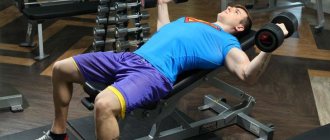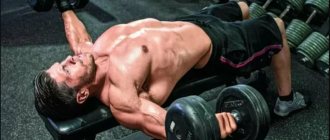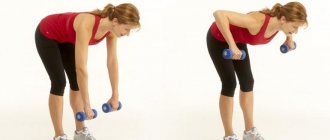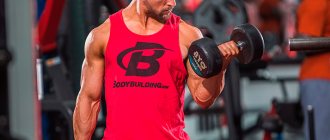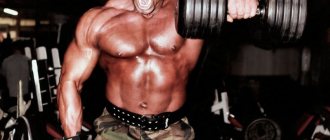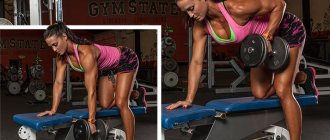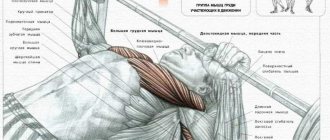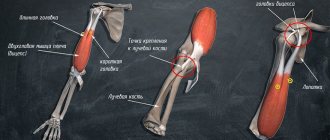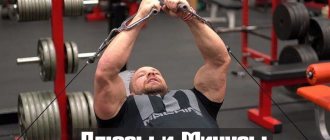Today we’ll take a closer look at exercises such as incline dumbbell chest presses and dumbbell bicep curls. Experts recognize them as one of the most effective for the development of good muscles.
Both of these exercises have a greater impact on the upper part of the muscle fibers, while effectively working the entire area of the pectoral muscles. But for a harmoniously developed body, maintaining proportions is very important. Therefore, you should not ignore exercises on an incline bench if you want to be in excellent physical shape.
Features of the Incline Chest Press
The incline bench press engages all the muscle fibers of the chest area, which for guys will provide them with high-quality growth, and for girls it will create a beautiful chest line. To achieve the desired results, it is important to follow the correct technique.
In terms of effectiveness, this exercise is in second place - right after the classic press on a straight bench. What special does a regular incline bench give to the exercise?
The thing is that the chest press on a horizontal bench activates mainly the lower part of the pectoral muscles. That is, the upper part of the muscles in this area of the chest is little worked out.
And in order to get a harmonious pectoral structure, you need to go through all the muscles. When you lie on a bench with your head up, that is, it is above the level of your legs, the load from the dumbbells is evenly distributed over the entire area of the pectoral muscles.
In addition to the fact that the incline press with dumbbells is good for tightening the upper part of the pectoral muscles, it generally allows you to better stretch the muscle fibers. This is due to the fact that the barbell press slightly reduces the amplitude at the bottom. With dumbbells, you can lower your arms below chest level, that is, you will better stretch your muscles.
An increase in amplitude also proportionally increases the load - you work harder, with greater impact. The combination of these two qualities ensures muscle growth.
One-arm dumbbell press
This exercise is almost the same as the two-arm press. Regardless of this, you need to monitor the correct execution technique. The downside is that the hands do not work simultaneously, but in turn, which makes fatigue appear faster.
In principle, everything is done in the same way as when working with two hands. It is worth recalling just a couple of main points:
- The downward movement lasts twice as long as the upward movement.
- Avoid lifting too much weight at once to avoid injury.
Proper bench press technique
So, we have found out which muscles work when doing an incline bench press, now we can move on to the features of the exercise itself. There are several of them:
- The tilt angle should be 25-30 degrees, no more. A smaller or larger figure will involve the triceps or deltoids, which reduces the load directly on the chest.
- The dumbbell press on an incline bench has a completely different nature of movement due to the fact that it is performed with so-called free weight. Therefore, you will not be able to lift the same weight in this exercise as you would on a barbell press.
- The third follows from the second feature - in the incline press you cannot chase the weights. Too much weight will prevent you from maintaining proper technique.
- During the exercise, make sure that your back is pressed tightly against the bench - there should be no arching in the lower back.
- The movement begins from the top point - while inhaling, the dumbbells smoothly lower to the chest, while the elbows go down, significantly below chest level. As you exhale, the dumbbells are also smoothly lifted up - the arms are not straightened completely, the dumbbells do not touch each other.
By following the above technique, you can achieve high-quality development of the pectoral muscles. This same exercise should not be ignored by girls, for whom there will be no differences in technique.
The only remark is that it makes no sense for them to devote a separate day in the gym to training the pectoral muscles due to the less “responsiveness” of the pectoral muscles in the fair sex. In addition, not a single girl will set herself the goal of pumping up her chest.
Program for training the pectoral muscles
1Dumbbell Bench Press2 Incline Dumbbell Press3Dumbbell fly4Push upsThe program can be used both in the gym and at home (you can use a step platform as a bench)
Number of repetitions and approaches
During a high-intensity fat-loss workout, it's best to perform 12-15 reps of 3 sets for each exercise to maintain intensity. Beginners are also recommended to do at least 12 repetitions with a small weight so that the technique is properly learned, the body remembers the mechanics of the movements and the load can be gradually increased without the risk of injury. Start with the lightest dumbbells and try to do more reps each workout (with proper technique!) than the last.
When you can easily do all 15 repetitions, you need to take heavier dumbbells.
If the main goal of the workout is to increase muscle mass, then the recommended number of repetitions is from 6 to 8 (depending on the weight of the dumbbells) in 3-5 sets.
The 12 reps/3 sets option for chest exercises may be a compromise between fat loss and muscle building, but this approach works mainly for those who have not trained before.
Dumbbell Bench Press
The dumbbell bench press is more effective at increasing pectoral size than the barbell bench press because the dumbbell bench press allows for a greater range of motion.
Technique:
- lying on a bench, raise dumbbells in front of you, arms shoulder-width apart, palms facing away from you;
- bend your arms so that your shoulder and forearm are at an angle of 90 degrees;
- while exhaling, push the dumbbells up (lifting the dumbbells should take half as much time as lowering them down);
- when lowering the dumbbells down, bring your shoulder blades together and stretch your chest, and when lifting them up, squeeze your chest;
- After completing the set, do not throw the dumbbells, as you can damage the rotator cuff; Holding the dumbbells down, turn your palms towards each other and lower the dumbbells to your hips, then sit down and lower them to the floor.
Incline Dumbbell Press
The incline dumbbell press allows you to increase the load on the upper chest.
In the gym, you must use a bench whose inclination angle can be adjusted.
Technique:
- the greater the inclination of the bench, the greater part of the load is taken on by the shoulders;
- arms at the top point should be perpendicular to the floor;
- Otherwise, the technique is the same as when pressing dumbbells on a flat bench.
Dumbbell fly
Technique:
- lying on a bench, raise dumbbells in front of you, arms shoulder-width apart, palms facing each other;
- while inhaling, lower your arms down to the sides, stretching your chest (the movement is carried out only in the shoulder joint);
- As you exhale, bring your arms together in a “hug” motion.
Flyes can be done in the same way as bench presses on an incline bench (in the gym).
Basic mistakes
Common mistakes when bench pressing dumbbells:
- uneven descent;
- lowering the projectile to the belt or to the head;
- not a hard grip;
- uncontrolled lowering (coordination);
- not rigid fixation of the legs on the floor.
I also recommend reading my article on the most effective exercises for chest training.
Initial position
Lie on an incline bench with dumbbells in your arms bent to your shoulders. To take the starting position, you can first take dumbbells from the floor, throw them on your chest, and then sit on the edge of the bench and lie on the inclined part. If you are working out with a partner, he can help you grab the dumbbells and get ready for the exercise.
Another quite convenient way is to help yourself with your hips. First, take the dumbbells in your hands. Then sit on the bench. Place the dumbbells vertically on your thighs. Next, lean back and immediately help yourself with your hips so that the dumbbells are at your shoulders.
Before you start pressing the dumbbells, spread your elbows out to the sides.
Execution technique
The technique for performing the exercise is as follows:
- The bench is installed at an angle of 45 degrees. You need to sit on it in such a way that you rest well on the back. Hold dumbbells in your hands with your palms facing inward.
- Inhale and exhale, and as you exhale, without jerking, raise your arm at the elbow. When the forearm is parallel to the floor, turn the palm with the dumbbell inward (towards the biceps).
- There is no need to bend your arm until the dumbbell touches your arm - just as when extending, you do not need to achieve a straight arm at the end of the movement.
- The elbows remain motionless during execution - do not bring them back or to the sides.
This exercise can be performed with both hands at the same time or alternately. If we take into account the opinion of professionals, then such work on the biceps is mandatory - that is, the incline bench press is one of the basic elements.
Technique
- First of all, you need to install an incline bench. The dumbbell bench press is performed at an angle of 15-35 degrees (30 degrees). This position is the most optimal for the chest muscles. In addition, in this position they will be maximally involved, since the work of the deltoids and triceps is reduced to a minimum.
- The advantage of dumbbells is that, unlike the barbell press, there is no bar that interferes with movements. This provides an increase in amplitude, which is very beneficial for the muscles.
- To start the exercise, you need to take the starting position on a bench fixed at the desired angle: lie down, straighten your spine, place your feet on the bench or floor for stability, press your back to the surface of the bench. When performing a bench press, it is important to monitor the position of your hands: they should move strictly parallel to each other.
- If you have previously performed this exercise with a barbell, then with dumbbells you will have a new sensation: when your hands reach the lowest point, you will certainly feel the chest muscles stretching. Also, stabilizing muscles will be connected here, the work of which was not done before due to the bar.
- It is also important to take your time while performing this exercise. When your arms are at their lowest point, hold for a couple of seconds, allowing your chest muscles to stretch as much as possible.
- To distribute the load evenly across your chest, keep your elbows turned out and pointed towards your ears.
Differences between dumbbell and barbell presses
The dumbbell bench press is a basic exercise in bodybuilding and powerlifting. This is what is included in powerlifting. To increase performance in barbell exercises (such as barbell clusters), the lifter performs dumbbell overhead presses. There are several differences in working with these sports equipment. You can also highlight a number of advantages of training with dumbbells:
- Safety. Exercising with a barbell in an empty gym is not safe. A heavy projectile can simply crush the athlete. If you exercise without a partner or trainer, and are not confident in your abilities, then use dumbbells. They can be easily lowered without causing injury.
- Range of motion. While working with a barbell, the athlete is limited to a clear trajectory of movement. The bar connects the two hands. Thus, the athlete cannot increase the amplitude of the set. When working with a barbell, the pectoral muscles will not receive the proper load. By performing exercises with dumbbells, you will increase the mobility of your joints. These movements are considered more natural for a bodybuilder's body.
- Opportunity to improve coordination of movements. Since the athlete will need to perform exercises with two sports equipment at once, he will be able to quickly and effectively improve the neuromuscular connection in the human body. The athlete will improve coordination of movements. This skill will also help in everyday life.
- Independence. Possibility to work two hands in turn. This feature of the dumbbell upward press is very important for athletes after an injury. Additional load on the target area will help eliminate imbalances in the development of different thoracic regions. During the barbell press, only the strong arm will do the main work. Using dumbbells, the bodybuilder plunges the right and left sides of the body equally. Thus, you can quickly eliminate the imbalance in strength indicators, as well as in the proportions of the athlete’s figure.
- Versatility. Using dumbbells, a bodybuilder can pump up all muscle groups in the body. Working with this sports equipment is safe and also very comfortable. The athlete has access to a huge number of both basic and isolation movements.
- Ability to use the projectile in different conditions. Dumbbells are small-sized sports equipment that take up little space. They are very easy to store at home. You can also take this projectile with you during long car trips. This way you can always effectively maintain your physical fitness.
In addition to the positive aspects, there are a number of disadvantages to performing the bench press with dumbbells. The most basic disadvantage can be considered the small weight of the shells. To exercise effectively, you must have a huge number of dumbbells. But the problem can be solved by purchasing a gym membership. Even in the simplest rocking chair you can find sports equipment that is suitable for your activities.
